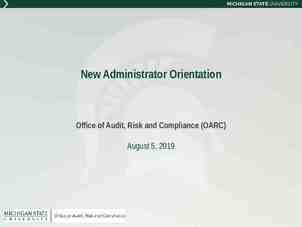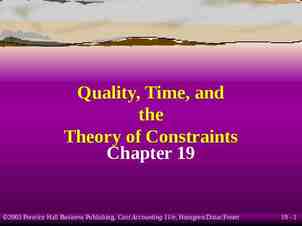IBU5COV Corporate Venturing Module 2: Introduction to corporate
15 Slides197.52 KB

IBU5COV Corporate Venturing Module 2: Introduction to corporate entrepreneurship and innovation Chapter 7 Morris et al. (2011) Human Resources and the Entrepreneurial Organization: The Organizational Perspective Prof. Alex Maritz & Dr. Anton de Waal La Trobe Business School January 2017 latrobe.edu.au CRICOS Provider 00115M

Understanding the HRM Function A firm’s human resource management is more strategic in its approach compared to the traditional personnel function HR practices are coordinated in a way that reflect: What is happening in the external competitive environment A longer-term focus Ways in which the skills and behaviors of all employees can be affected in a manner that supports and helps accomplish the overall strategies of the firm La Trobe University 2

Using Key Elements of the HRM System to Create an Entrepreneurial Environment Job Planning and Design: What are employees asked to do and how do we allow them room to show initiative? Recruitment and Selection: Who do we hire to be entrepreneurial and how do we hire them? Creating an Entrepreneurial Work Environment Compensation and Rewards: How do we incentivize employees to be entrepreneurial, take ownership, and stay with the company? La Trobe University Performance Appraisals: How do we guide, reinforce and help employees identify with entrepreneurial performance? Training and Development: How do we help employees recognize their entrepreneurial potential and develop the skills to best capitalize on that potential? 3

HRM and the Paradox of Creative Abrasion “Creative abrasion calls for the development of leadership styles that focus on first identifying and then incorporating polarized viewpoints. In doing so, the probabilities for unexpected juxtapositions are sharply increased, as are the levels of mutual understanding. The irony is that out of a process keyed on abrasiveness, a corporate culture of heightened sensitivity and harmony is achieved.” La Trobe University 4

Entrepreneurial Motivation Porter and Lawler’s Expectancy Model Expectation That: INDIVIDUAL MOTIVATION TO BE ENTREPRENEURIAL ON THE JOB is a function of EFFORT SPENT ON ENTREPRENEURI AL ACTIVITIES Importance Rating: will lead to SUCCESSFUL PERFORMANCE EVALUATION will lead to REWARD Perceived Equity La Trobe University 5

Entrepreneurial Motivation: The Critical Role of Reward Systems Reward and compensation programs are the most visible and influential parts of a company’s HRM system. People come to work to achieve varying degrees of the following rewards: Financial Power and status Personal development and career enhancement Self-actualization Social Friendships, camaraderie La Trobe University 6

Entrepreneurial Motivation: The Critical Role of Reward Systems The Expectancy Model (Porter and Lawler, 1968) Motivation is determined by: 1. How much a person perceives a direct relationship between the effort he/she puts forth and successful performance on the firm’s employee appraisal or evaluation system 2. How much that person perceives a direct relationship between a good performance appraisal and rewards 3. Whether the company is offering the correct rewards. La Trobe University 7

15 reasons employees might not be motivated to act entrepreneurial on the job: 1. Employees do not understand what management means by “being entrepreneurial on the job” 2. Believe it is not possible to accomplish entrepreneurial behavior in this company no matter how hard one tries 3. Perceive that they are not personally capable of being entrepreneurial, then he/she is likely to be unmotivated. Alternatively, the employee may believe that it is possible to be entrepreneurial, but they see no linkage between doing so and how they are evaluated 4. There is no formal appraisal or assessment of the employee 5. The performance appraisal criteria are unclear La Trobe University 8

15 reasons employees might not be motivate to act entrepreneurial on the job: 6. The criteria on which employees are evaluated do not explicitly include innovativeness, risk-taking and proactive efforts 7. Other non-entrepreneurial criteria receive much more emphasis 8. The evaluations are done in an arbitrary or unfair fashion 9. Managers asking for one behavior, but actually rewarding some quite different behavior 10. The employee believes the reward will be earned regardless of the evaluation (e.g., everyone around here gets the same reward) La Trobe University 9

15 reasons employees might not be motivate to act entrepreneurial on the job: 11. There are ways to get a good evaluation without actually doing entrepreneurial things (e.g., politicking). 12. The employee has come to find other ways to earn the reward without putting effort towards entrepreneurship (e.g., currying favor with the boss). 13. Rewards are being offered that are too small given the effort that is required to push an entrepreneurial initiative through in the face of lots of internal resistance 14. The type of reward being offered is not the one to which the employee currently attaches the most importance 15. The reward is considered inequitable or unfair, possible because of what the employee knows other people are receiving, especially when he/she thinks these other employees are performing to a lower standard. La Trobe University 10

Creative Approaches to Rewarding Employees: 1. 2. 3. 4. 5. Employees put a percentage of their salary at risk and then can either lose it, double it, or triple it based on team performance; Personalized “innovator” jackets, shirts, leather folders are given to employees who make entrepreneurial contributions; When a new idea is accepted by the firm, the CEO awards shares of stock to the employee; Employees are given 500 to spend on an innovative idea that relates to their job; A firm rents out a major sports stadium, fills the stands with employees, families and friends, and then has innovation champions run onto the field as their name and achievement appears on the scoreboard; La Trobe University 11

Creative Approaches to Rewarding Employees: (cont.) 6. 7. 8. A company sets targets, and then 30% of incremental earnings above target is placed into a bonus pool which is paid out based on each employee’s performance rating; Small cash awards are given to employees who try something new and fail---and the best failure of the quarter receives a larger award; Some companies have point systems where employees receive differing amounts of points for different categories of innovation contributions. Points are redeemable for computers, merchandise, free daycare, tuition reimbursement, and other types of rewards. La Trobe University 12

Additional guidelines for successful employee recognition programs as defined by Kanter (1994) Principle 1: Emphasize success rather than failure. Managers tend to miss the positives if they are busily searching for the negatives. Principle 2: Deliver recognition and reward in an open and publicized way. If not made public, recognition loses much of its impact and defeats much of the purpose for which it is provided. Principle 3: Provide recognition in a personal and honest manner. Avoid providing recognition that is too ‘slick’ or overproduced, but also too cheap or superficial. Principle 4: Tailor your recognition and reward to the unique needs of the people involved. Having many recognition and reward options will enable management to acknowledge accomplishment in ways appropriate to the particulars of a given situation, selecting from a larger menu of possibilities. La Trobe University 13

Principle 5: Timing is crucial. Recognize contributions throughout a project. Reward contributions close to the time an achievement is realized. Be sure people understand why they receive awards and the criteria used to determine rewards. Principle 6: Avoid their perception that the awards are being given in a manner that is paternalistic, and that seems random and casual. Principle 7: Strive for a clear, unambiguous and well-communicated connection between accomplishments and rewards. Be sure people understand why they receive awards and the criteria used to determine awards. Principle 8: Follow up on the recognition or award. Reinforce it in meetings, in newsletters, at end of the year meetings, an in employee annual reviews. Principle 9: Recognize recognition. That is, recognize people who recognize others for doing what is best for the company. La Trobe University 14

Subordinates’ View of the Entrepreneurial Manager Key Entrepreneurial Manager Behaviors Efficiently gets proposed actions through red tape and into practice; Displays enthusiasm for acquiring skills; Quickly changes course of action when results are not being achieved; Encourages others to take the initiative for their own ideas; Inspires others to think about their work in new and stimulating ways; Devotes time to helping others find ways to improve products and services; Goes to bat for good ideas of others; Boldly moves ahead with a promising new approach when others might be more cautious; Vividly describes how things could be in the future and what is needed to get there; Gets people to rally together to meet a challenge; Creates an environment where people get excited about making improvements. La Trobe University 15






